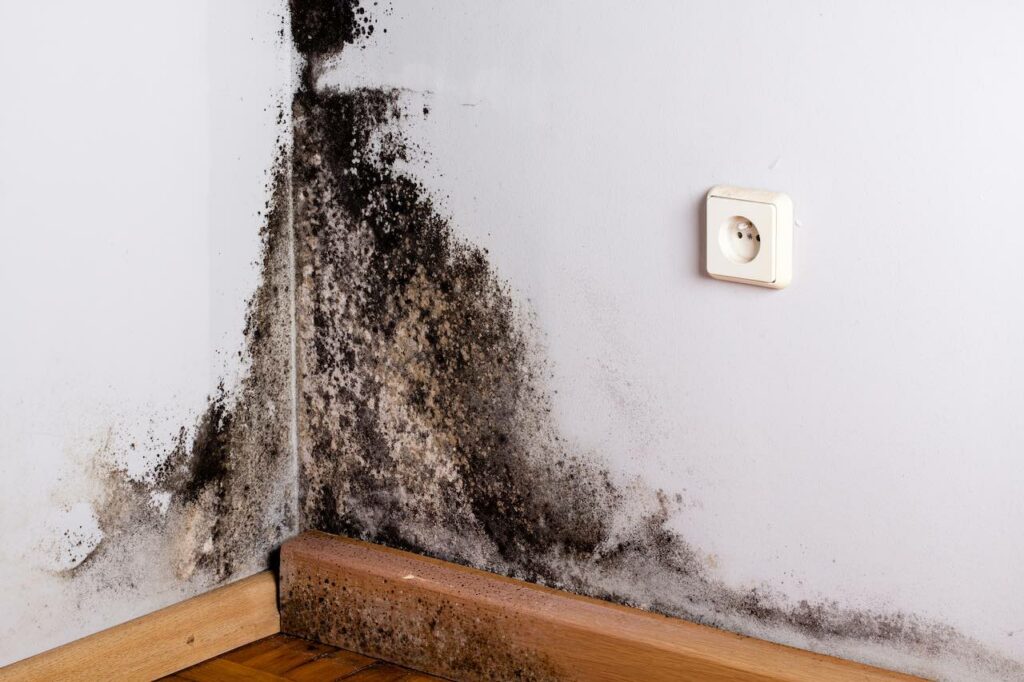
Color and toxicity of mold are two different things and both play a vital role in mold prevention. Just because a mold is black, does not mean it is toxic. And not all black molds are deadly. Mold can range in color depending on what materials provided the mold the food it needs to grow.
Even so, toxic or not, mold prevention is the key to a safer home.
What is Black Colored Mold?
A black colored mold has a black pigment by nature. It is usually associated with being the toxic kind, but that’s not always the case. Black mold may not be toxic, but it can be an allergenic.
Nigrospora is an example of a black colored mold.
There is no evidence it is toxic to humans or other living organisms.
The most common black mold is Cladosporium, which has no known toxic side effects. This type of mold is common both inside and outside of the home. Heavy exposure to black mold could trigger an increase in allergy and asthma symptoms.
Other black molds include Alternaria, Aureobasidium, Dresclera, Pithomyces, Stemphylium, and Ulocladium.
None of these are toxic molds that produce mycotoxins, but Altermaria can cause severe allergy symptoms.
What is Black Toxic Mold?
Black toxic mold is also known as Stachybotrys chartarum and is dark black or sometimes dark green. It is a highly toxic form of mold commonly found in attics.
This mold releases mycotoxins which are toxic chemicals that are present in mold spores that get released into the air and can then be inhaled.
Black toxic mold can cause danger to human health when ingested or inhaled. For this kind of mold to grow, the material would need to be wet for at least 72 hours and have consistent moisture for continued growth.
The Causes
Any type of mold capable of releasing mycotoxins is definitely toxic. Many times, the cause of mold growth in an attic is due to improper ventilation.
An example is the bathroom exhaust fan, which vents towards the attic, instead of outside the house. This poor system setup will produce moist, humid air which filters up to the attic and can trigger the growth of black toxic mold.
Another possibility is flooding or leaks which have been stagnant for a long time. The food source for the mold must be high in cellulose and low in nitrogen to grow rapidly.
Blocked attic vents may trigger the growth of black mold. When making repairs, be sure to turn off the power source before removing the blockage. Once the mold is removed, the attic vent should work to remove the moisture from the attic.
The Effects
Black toxic mold can cause serious health problems. The damage depends on the length of exposure and how many spores were inhaled.
In cases of non-toxic mold strains, there can still be allergenic reactions, especially in more sensitive individuals.
For mold prevention to work, you must find the root cause of the moisture. Mold spores are naturally floating out in the environment, wet natural materials will allow the spores to settle and grow.
Symptoms
Mold prevention is always an option, but ignorance can unintentionally bring on a lot of health issues.
The respiratory system is a common target for mold exposure. Rashes, chronic coughing, sneezing and fatigue, irritation to the eyes and mucous membranes of the nose and throat, and persistent headaches are all symptoms of exposure to toxic mold.
Longer exposure to toxic mold can be even more dangerous. Nausea, vomiting, and bleeding in the lungs and nose are symptoms of allergic reaction.
Moreover, it can also attack the mental and neurological state of a person. The trichothecene mycotoxins produced by black toxic mold are neurotoxic. This means they can kill neurons in the brain and destroy a person’s mental abilities. They may also cause nervous system disorders such as tremors or personality changes such as mood swings and irritability.
The mycotoxins then find their way into the person’s bloodstream. This leads to heart damage and may cause problems with blood clotting and internal or external hemorrhaging. When mycotoxins come into contact with eye cells, they cause inflamed and injured eyes resulting in vision problems.
Black toxic mold can also cause soreness of the muscles and joints and tiredness, in general.
Mold Prevention
Mold prevention is always the best defense to stopping mold growth. If you see growing mold anywhere in your home, you should remove it immediately.
Use proper precautionary tools like a mask and cover parts of your body that are exposed. You can’t risk the exposure to hazardous spores.
If the problem is larger than you can handle or you have health issues, it is best to contact a professional to have mold removed.
Once everything is clean, it is your responsibility to keep it that way. Make sure all leaks have been fixed, all contaminated materials have been properly disposed of, and continue to keep previously affected areas free and clear of dust and moisture.
You should monitor the humidity levels in your home frequently because too much humidity can trigger mold growth. Check your air-conditioning unit regularly to make sure it is running properly. Check for stagnant or standing water in and around your home. You might consider covering the floor of your crawl space as moisture might collect there. Moreover, you should invest in a dehumidifier to help you control humid air especially if you have a basement or indoor crawl space.
You have to understand the dangers of mold to follow the mold prevention process. Identifying the moisture source is the key to eliminating the problem.
You can do-it-yourself, but if you cannot pinpoint the source of the moisture, it is advisable to contact a professional.







